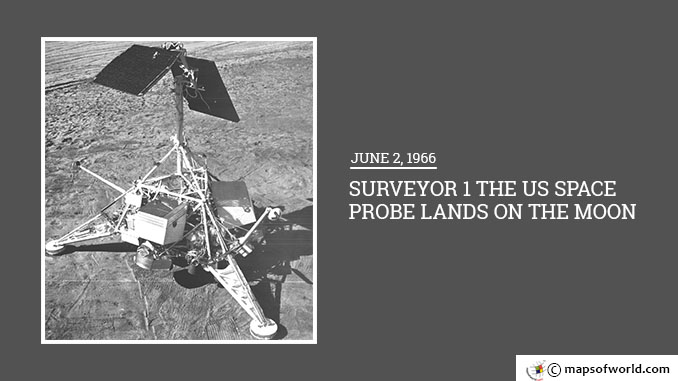Surveyor 1, the earliest of the seven robotic surveyor space crafts, sent to the lunar surface to collect data for National Aeronautics and Space Administration’s (NASA) Apollo missions, landed on the moon on June 2, 1966 at 6:17 hours UTC. Surveyor 1 became the first spacecraft to make a true soft landing on the lunar surface. The Apollo moon missions were manned missions to the moon which commenced in 1969. The Surveyors were unmanned crafts sent to the moon to gather information about the terrain, weather, surface, and other conditions of the moon to facilitate the landing of astronauts. On May 30, 1966, Surveyor 1 was launched from the Cape Canaveral Air Force Station at Cape Canaveral in Florida at 14:41 hours UTC. The low-speed landing on June 2 was achieved after a 63-hour, 36-minute flight from Cape Kennedy. Surveyor 1 was designed and built for NASA by the Hughes Aircraft Company of Culver City in the state of California. Technical guidance was provided by the Jet Propulsion Laboratory of Pasadena. The rocket used to launch the Surveyor 1 was an Atlas-Centaur. Upon launch, Surveyor 1 was not sent into a parking orbit, but directly into a trajectory to the Moon. As it neared approach, the retrorockets were turned off and Surveyor 1 fell freely to the moon’s surface. The probe hit the lunar surface at the Oceanus Procellarum. Surveyor 1’s launch weight was about 995.2 kilograms (2,194 lbs) and its landing weight was about 294.3 kilograms (649 lbs). Since the Moon always presents the same face to Earth, a rotation in Earth’s ground stations kept communication steady. The one hitch faced by Surveyor 1 was the lack of electricity. The probe depended on solar energy and the fortnight-long lunar nights caused periods of inaction. In preparation for the Apollo missions, Surveyor 1 transmitted 11,237 still photos of the moon to the scientists at NASA. The Surveyor was fitted with a camera and a complicated radio-telemetry system. Being the earliest of the probes, Surveyor 1 was not equipped to carry out scientific experiments and its greatest contribution was the photos it relayed from the lunar surface captured with the help of a television camera and transmitted through the Deep Space Network. The return of information from Surveyor 1 continued through January 7, 1967 which was the mission end date. Surveyor 1 was followed by six other probe missions and the manned Apollo mission. Also On This Day: 1840 – Thomas Hardy is born. 1910 – Charles Rolls becomes the first man to make a non-stop double crossing of the English Channel. 1924 – The Indian Citizenship Act is signed into law. 1953 – Queen Elizabeth II is coronated.
June 2 1966 – Surveyor 1 the US Space Probe Lands on the Moon
Surveyor 1, the earliest of the seven robotic surveyor space crafts, sent to the lunar surface to collect data for National Aeronautics and Space Administration’s (NASA) Apollo missions, landed on…
778
